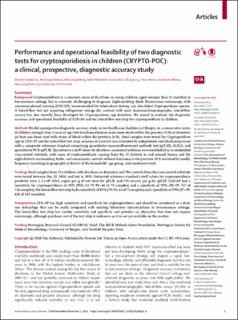| dc.contributor.author | Johansen, Øystein Haarklau | |
| dc.contributor.author | Abdissa, Alemseged | |
| dc.contributor.author | Zangenberg, Mike | |
| dc.contributor.author | Mekonnen, Zeleke | |
| dc.contributor.author | Eshetu, Beza | |
| dc.contributor.author | Bjørang, Ola | |
| dc.contributor.author | Alemu, Yonas | |
| dc.contributor.author | Sharew, Bizuwarek | |
| dc.contributor.author | Langeland, Nina | |
| dc.contributor.author | Robertson, Lucy | |
| dc.contributor.author | Hanevik, Kurt | |
| dc.date.accessioned | 2021-02-10T11:59:31Z | |
| dc.date.available | 2021-02-10T11:59:31Z | |
| dc.date.created | 2020-12-09T12:21:29Z | |
| dc.date.issued | 2021 | |
| dc.identifier.issn | 1473-3099 | |
| dc.identifier.uri | https://hdl.handle.net/11250/2727180 | |
| dc.description.abstract | Background: Cryptosporidiosis is a common cause of diarrhoea in young children (aged younger than 24 months) in low-resource settings but is currently challenging to diagnose. Light-emitting diode fluorescence microscopy with auramine-phenol staining (LED-AP), recommended for tuberculosis testing, can also detect Cryptosporidium species. A lateral-flow test not requiring refrigerator storage (by contrast with most immunochromatographic lateral-flow assays) has also recently been developed for Cryptosporidium spp detection. We aimed to evaluate the diagnostic accuracy and operational feasibility of LED-AP and the lateral-flow test strip for cryptosporidiosis in children.
Methods: We did a prospective diagnostic accuracy study in two health-care facilities in Ethiopia, in a consecutive series of children younger than 5 years of age with diarrhoea (three or more loose stools within the previous 24 h) or dysentery (at least one loose stool with stains of blood within the previous 24 h). Stool samples were tested for Cryptosporidium spp by LED-AP and the lateral-flow test strip; accuracy of each test was estimated by independent and blind comparison with a composite reference standard comprising quantitative immunofluorescent antibody test (qIFAT), ELISA, and quantitative PCR (qPCR). Quantitative cutoff values for diarrhoea-associated infection were established in an embedded case-control substudy, with cases of cryptosporidiosis coming from the 15 districts in and around Jimma and the eight districts surrounding Serbo, and community controls without diarrhoea in the previous 48 h recruited by weekly frequency matching by geographical district of the household, age group, and enrolment week.
Findings: Stool samples from 912 children with diarrhoea or dysentery and 706 controls from the case-control substudy were tested between Dec 22, 2016, and July 6, 2018. Estimated reference-standard cutoff values for cryptosporidiosis positivity were 2·3 × 105 DNA copies per g of wet stool for qPCR, and 725 oocysts per g for qIFAT. LED-AP had a sensitivity for cryptosporidiosis of 88% (95% CI 79–94; 66 of 75 samples) and a specificity of 99% (98–99; 717 of 726 samples); the lateral-flow test strip had a sensitivity of 89% (79–94; 63 of 71 samples) and a specificity of 99% (97–99; 626 of 635 samples).
Interpretation: LED-AP has high sensitivity and specificity for cryptosporidiosis and should be considered as a dual-use technology that can be easily integrated with existing laboratory infrastructures in low-resource settings. The lateral-flow test strip has similar sensitivity and specificity and provides an alternative that does not require microscopy, although purchase cost of the test strip is unknown as it is not yet available on the market. | |
| dc.language.iso | eng | en_US |
| dc.publisher | Elsevier | en_US |
| dc.rights | Navngivelse 4.0 Internasjonal | * |
| dc.rights.uri | http://creativecommons.org/licenses/by/4.0/deed.no | * |
| dc.title | Performance and operational feasibility of two diagnostic tests for cryptosporidiosis in children (CRYPTO-POC): a clinical, prospective, diagnostic accuracy study | en_US |
| dc.type | Journal article | en_US |
| dc.type | Peer reviewed | en_US |
| dc.description.version | publishedVersion | en_US |
| dc.rights.holder | Copyright 2020 The Author(s). | en_US |
| cristin.ispublished | true | |
| cristin.fulltext | original | |
| cristin.qualitycode | 2 | |
| dc.identifier.doi | 10.1016/S1473-3099(20)30556-9 | |
| dc.identifier.cristin | 1857891 | |
| dc.source.journal | Lancet. Infectious Diseases | en_US |
| dc.source.pagenumber | 722-730 | |
| dc.identifier.citation | Lancet. Infectious Diseases, 2021, 21 (5), 722-730. | |
| dc.source.volume | 21 | |
| dc.source.issue | 5 | |

